Designers and florists praised the Cirrus cultivar for its lush appearance, as well as for its ability to grow upward with supports and ampelo in a flower pot, flowing out of openwork shoots with waterfalls. It adapts well to the room, it feels normal under completely artificial lighting, which makes it popular in office landscaping. Cirrus asparagus is often bred at home due to the fact that caring for it is not particularly difficult, and openwork greens will decorate any interior.
In philosophy, feng shui shrub refers to the species that cleans the house of negative energy, and helps people in times of emotional decline or depression. Lush, bright shoots are used by florists in bouquets, and in alternative medicine, tincture from this plant is used to treat various diseases.
Content
Characterization of Cirrus Asparagus
Cirrus asparagus (or Cirrus asparagus) is an evergreen, perennial bush that belongs to the Asparagus family. The place, as well as the time of appearance, is not known exactly. It grows in tropical and subtropical forests. The stems are thin, curly, grow in a bunch-like fashion, with up to 12 stems in each bunch. Length can reach up to 1.5 meters. In young plants, they are erect.
The leaves are modified into narrow short flakes that resemble needles and participate in photosynthesis. The length of soft scales is up to 1.5 cm, and in diameter no more than 0.5 cm. The root system grows rapidly and consists of bulbous tubers and thin interwoven roots.
Flowers have a white color, but in an apartment, the plant rarely blooms. Buds can grow alone, and can be collected in inflorescences. They have six stamens, the structure resembles lily flowers. Fruits are blue-black or red - poisonous, cause irritation and an allergic reaction. When eaten, they cause poisoning. To get the fruits, you need to conduct a pollination procedure. Usually it is carried out if you want to get seeds that are contained in overripe berries.
Cirrus Asparagus Care at Home
At home, Cirrus Asparagus feels comfortable. If you provide it with sufficient light and moisture, the plant will delight with a decorative look all year round.
Lighting
Light-loving plant. It tolerates bright, but diffused light. He feels comfortable on the windowsills of the western and eastern sides. On the southern windows it is necessary to shade with special films or other devices.
the end of spring is recommended to take the pot out, if possible. The time spent in the fresh air is gradually increased, starting from 5-10 minutes. But set so that direct sunlight does not fall on the leaves. In winter, you can not use additional lighting, the plant will tolerate a short daylight.
 You may be interested in:
You may be interested in:Temperature and humidity
The heat-loving asparagus feels good in the summer at a temperature of +25 ° C. In winter, it is desirable that the thermometer column drops no lower than to +14 ° C.
Humidity should be monitored regularly. Spraying is carried out often enough. Once a day at room temperature and twice if the air is dry or the temperature is above 25 ° C. You can purchase a humidifier based on the square of the room. You can also moisten the soil by pouring wet gravel into the pan. Stones must be washed once a week so that the water does not stagnate there.
Watering and feeding
A tropical flower needs watering 2-3 times a week. When it is hot and the soil dries faster, water more often. Watch the pan - excess water must be drained, because stagnation will provoke the development of rot in the root system. In winter, a dormant period sets in, when watering is reduced, but the soil cannot completely dry out. Irrigation water is taken only filtered or settled at room temperature.
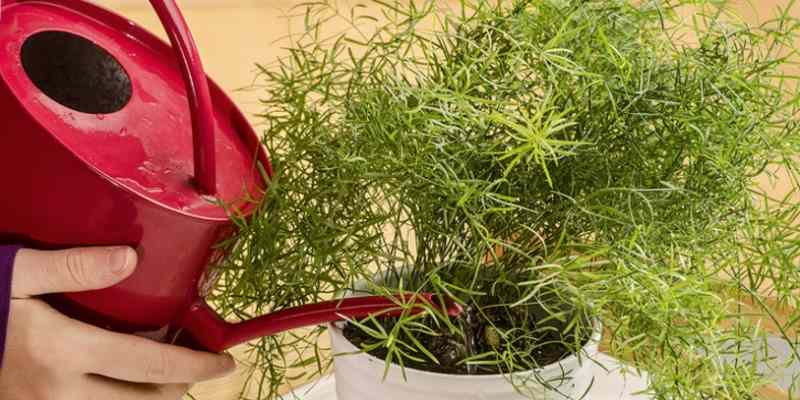
Feeding is carried out all year round, alternating organic and mineral fertilizers. Particular attention is paid to this issue in the spring, during a period of active growth. From March to October-November, fertilizer can be applied once a week, in winter - once a month.
Flowering, fruiting, pruning
Indoor asparagus can rarely produce flowers. But sometimes, when the conditions were created close to natural, the plant will appreciate the small white flowers that will be folded into inflorescences. At this stage, fruiting can be achieved by artificial pollination. To do this, use a cotton swab or a brush to collect pollen in one flower and transfer it to another. The berries have a bright red color and are very poisonous, so pollination is usually not used in an apartment.
The cirrus variety does not tolerate pruning or pinching. After them, the shoot stops growing and can destroy the whole flower. The only case when pruning is shown is only the removal of dry, lifeless shoots, so that the flower does not waste strength and nutrients on them. This procedure is performed when replanting in the spring.
Winter preparations
In winter, asparagus Cirrus dormancy. To recreate these conditions in the apartment, it is necessary to lower the room temperature to 14 ° C (if this is not done, then the green mass may begin to thin):
- Watering is gradually reduced, it can be replaced by lower watering through the pan, but it will be necessary to ensure that water does not stagnate in it.
- Fertilizing is reduced to a minimum, you can stop it altogether.
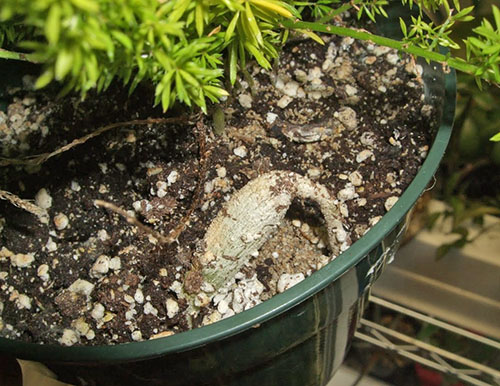
Plant nutrition - For the pot, choose the sunniest place, but so that there are no heating appliances and drafts nearby.
- Artificial additional lighting is not necessary, but with it the plant is more comfortable.
- Dry air adversely affects the tropical flower, so increase the amount of irrigation with filtered water. Decorative fountains, water bowls on the windowsill or wet expanded clay in the pan also help to increase the level of humidity.
What to do if asparagus turns yellow?
Yellowing or shedding of altered leaves is a common cause of concern for novice gardeners. To prevent this phenomenon, you need to understand what factor or their combination influenced it.
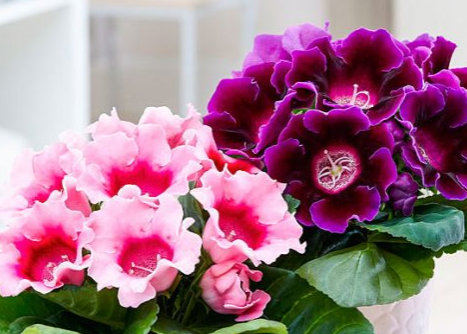 You may be interested in:
You may be interested in:Such errors in care can provoke yellowing of a flower:
- Lack of proper watering.Regular watering is important, but it all depends on the season, temperature and humidity in the room. It is necessary to follow the earthen lump. Drying it will lead to unpleasant consequences. To avoid this, flower growers can admit another extreme - they fill a flower. And this leads to the same result, because when the roots rot, the plant can also turn yellow and even drop leaves.
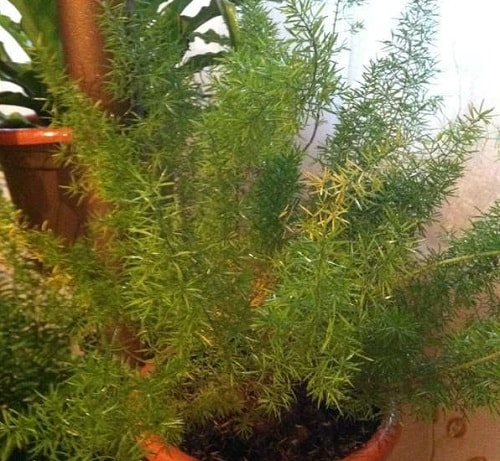
Yellowing leaves - Errors in lighting. Bright direct sunlight burns the foliage, which looks like yellowing and leads to falling. Dim lighting is also harmful - the plant loses its decorative appearance and begins to fade. It is important that sufficient light is incident on the plant. During a stay on the street, a shaded location is also selected, without direct light entering the bush.
- Reduced air dryness. Asparagus comes from the tropics, so dry air immediately affects the beauty of the leaves - they begin to curl and dry. To ensure comfortable conditions, you need to regularly irrigate the flower and monitor the level of humidity in the room.
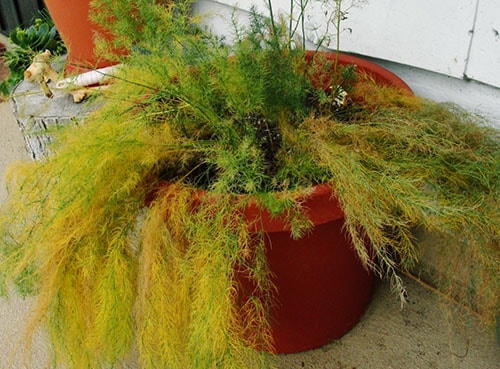
Reasons for yellowing - Not enough fertilizer. Asparagus is fed almost year-round. This provides a rich color and density of the crown. When a plant does not receive enough nutrients, this affects the decorative effect. The leaves turn yellow and thin.
- Irregular transplant. The root system grows very quickly and occupies the entire area of the pot. This leads to the fact that growth slows down, nutrients are not enough and the bush begins to turn yellow and drop leaves. Transplantation of flowers once every 3 years is enough for adult flowers, and young need annual transshipment, since they are actively growing.
Transplantation and reproduction of cirrus asparagus
Asparagus has rapidly developing roots, therefore, as already mentioned, a young plant is replanted every year, and an adult every 2-3 years, while all dried shoots and part of the root system are removed. Transplanted by transshipment, as it is less traumatic for the roots. The process takes place according to this algorithm:
- Pick up a pot. In size, it should be slightly larger than the old one, but not too spacious so as not to stimulate the roots to too active growth, which will negatively affect the decorative appearance of the bush.
- Lay the drainage layer on the bottom of the pot, pour a small layer of fresh soil mixture on top.
- A few days before transplanting, water the plant so that the earth is loose and easily removed from the pot.
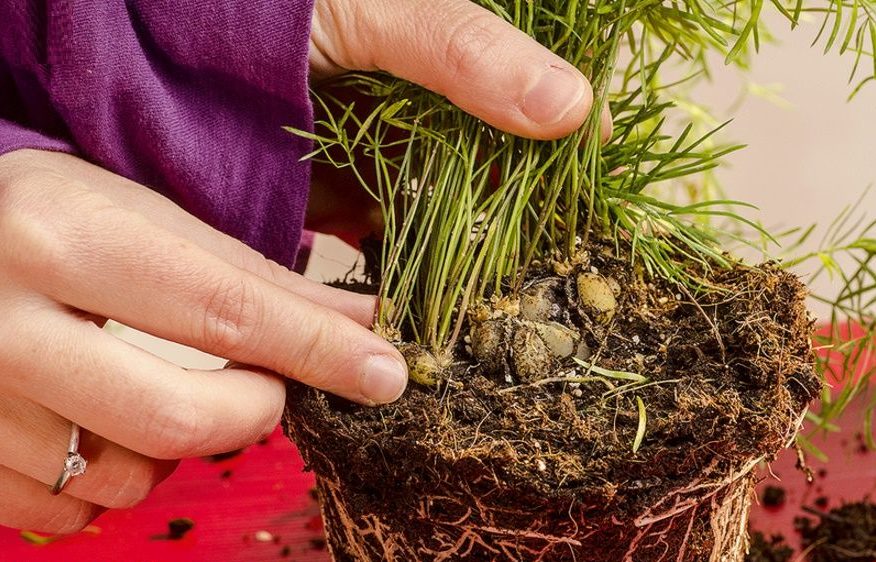
Features of a flower transplant - Carefully remove the flower from the old container. Inspect for damage, trim them with a clean pruner and treat with crushed charcoal or another antiseptic.
- Trying not to damage the roots, put the bush in a new pot and fill the remaining space with earth. Leave free space up to the top of the pot, as a sprawling root system raises the soil higher.
- Pour with soft water and put in a warm, lit place.
Reproduction occurs by cuttings, division of the root system and seeds:
- Cuttings are the most complex form, since the shoots are not well rooted with it.
- Reproduction by dividing the roots is painful enough for the flower and is justified only for very overgrown plants. It is carried out according to the transplantation algorithm, but after extraction from the old pot, the root system is divided into several parts and treated with an antiseptic. Pots are selected small so that the plant does not spend energy on growth, but can restore roots. Small bushes can be sick for a long time after transplantation, require very careful care.
- Obtaining new plants from seeds is a fairly common method. Seeds can be purchased at the store or collected from the overripe fruit of the flower, if you can achieve flowering.
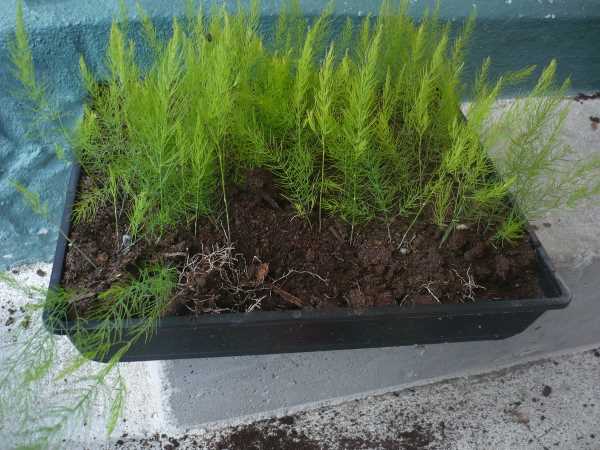
Seed asparagus Sow according to this algorithm:
- soak the seeds in a solution of potassium permanganate for 3 days;
- pick up a wide capacity for sowing;
- prepare the soil mixture - store soil for ferns is well suited;
- submerge the seeds to a shallow depth;
- pour warm soft water;
- cover with a film, which must be removed every day for a short time for ventilation;
- put in a warm place with diffused light;
- seedlings will appear in a month;
- when their height is about 15 cm, they can be transplanted into pots.
Common Indoor Growing Questions
When growing the Cirrus species of asparagus, questions arise regarding the conditions of detention or the safety of the room culture.
A lush, evergreen shrub will decorate any interior. The modified leaves resemble Christmas needles and create a decorative openwork. In plant care, the plant is quite unpretentious, but often suffers from leaf fall and yellowing if conditions of comfortable maintenance have been violated. This can be avoided if you familiarize yourself with the basic rules of care before purchasing and comply with them as much as possible.


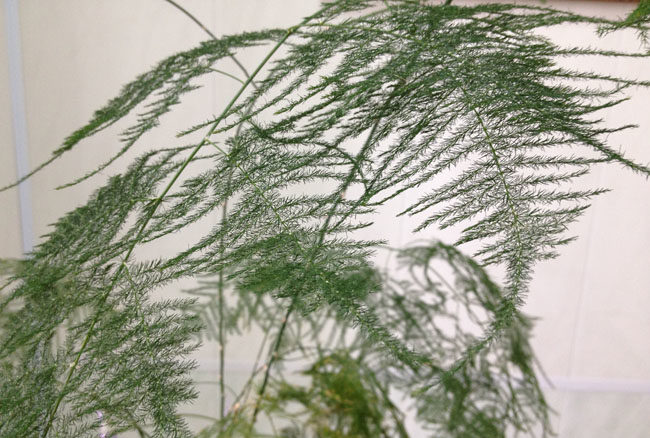
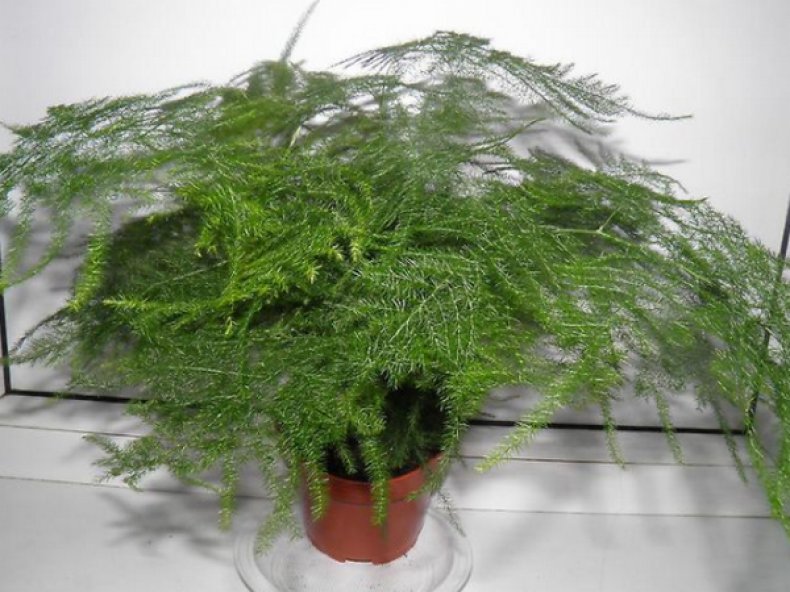



 Sow in the ground, without seedlings: 10 beautiful and unpretentious flowers
Sow in the ground, without seedlings: 10 beautiful and unpretentious flowers Platicodon planting and outdoor care
Platicodon planting and outdoor care Hosta - planting and care in the open ground in the Urals
Hosta - planting and care in the open ground in the Urals Oleander - care and growing at home
Oleander - care and growing at home